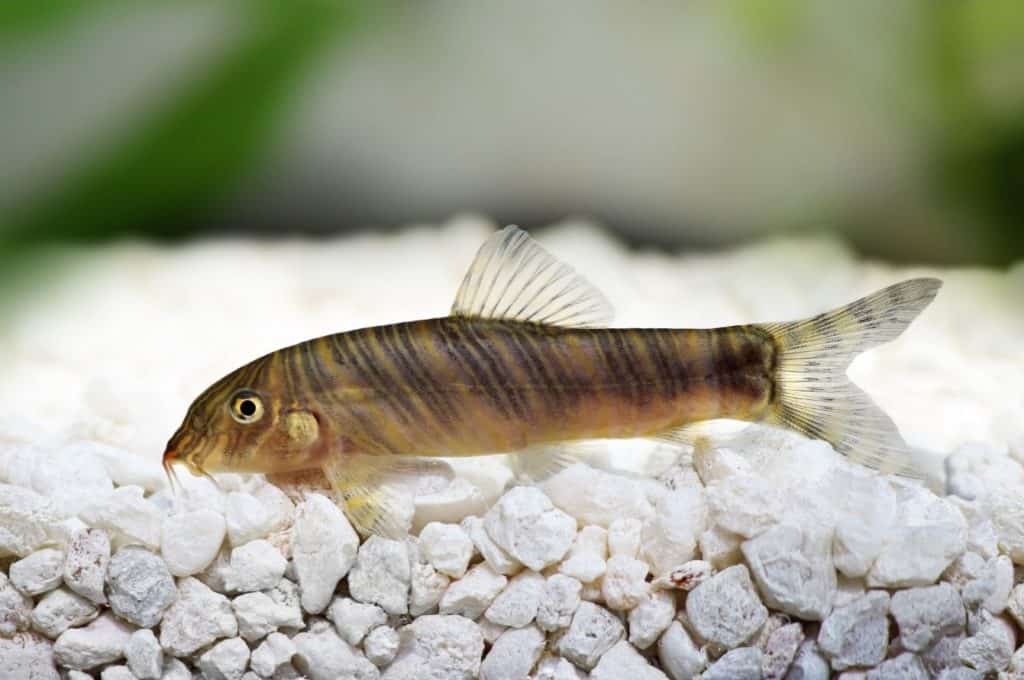The Zebra Loach, or Botia striata by its Latin name, is a lovely little freshwater fish that hails from the slow moving streams and rivers of west India. It is named after the beautiful and distinctive zebra striped pattern covering its body that makes it such a favorite among aquarists.
Not only is this fish beautiful, it is also easy to care for and will help to keep your tank clean by hoovering up any algae and detritus that may accumulate over time.

The Zebra Loach is a bottom feeder and likes to spend lots of its time munching in one place, which is why this species does not like fast moving currents.
They used to be prevalent in many more areas but sadly, due to deforestation, much of their natural habitat has been destroyed and they can now only be found in very small regions. In fact, the Zebra Loach is currently an endangered species, which is why aquarists should make sure to only buy Zebra Loaches that have been bred in captivity, and should read on to find out how best to keep them happy and healthy.
Care Guide
Tank Size
Zebra Loaches should ideally be kept in a tank of at least 30 gallons. This may seem excessive due to their small size, however it is important to have at least 5 Zebra Loaches in one group to keep them calm and content. Therefore, extra swimming space is necessary.
Tank Mates
Zebra Loaches are a very easy going species and they tend to swim along nicely with most freshwater tank mates. It is best not to put them in a community with any big or boisterous fish however, as the Zebra Loach prefers a chilled, slow moving life.
Freshwater fish of a similar size and temperament to their own are the best option. Some great tank mates include Cherry Barbs, Clown Loaches, Neon Tetras, Ember Tetras, Yoyo Loaches and Cory Catfish to name but a few.
However, try to avoid putting Zebra Loaches in a tank with freshwater snails as they may try to eat the smaller ones. Equally, they are prone to nipping the fins of Betta Fish or small cichlids.
Same Species Tanks
Really, Zebra Loaches love to be amongst other Zebra Loaches. It is very important that you have at least 5 in one tank, because any less and they begin to squabble amongst themselves and can become quite grumpy and distressed.
The more the merrier is the motto for these guys!
Water Parameters
Zebra Loaches are very popular among beginner aquarists due to the fact that they are low maintenance and hardy. However, if their water parameters are not correctly maintained then these fish will become unwell and very unhappy.
Therefore, it is important to perform regular water tests, once or twice weekly, and check that the acidity and temperature are suitable. You should also perform a partial water change of 25-30% once a week. Although the Zebra Loach loves to feed on algae, let their tank water become too murky and they could contrack illness and disease.
The PH levels in their tank should stay between 6 – 7.5, with a water hardness between 2 and10 dKH. The water temperature should be around 73 – 79 degrees Fahrenheit. As aforementioned, too much fluctuation, even between the extreme ends of these parameters, will upset your Zebra Loaches, so try to keep these figures as stable as possible.
What To Put In Their Tank
When deciding what decorations and vegetation to put in any aquarium it is important to consider the conditions of your fish’s natural habitat and then try to recreate that as authentically as possible. It is also a good idea to think about the fish’s behavioural habits and add decorations that assist rather than hinder them.
The Zebra Loach spends the majority of its time feeding on the bottom of the tank, therefore a soft substrate, such as sand, works well. Anything too harsh or sharp may harm their delicate bellies.
In west India the waters are lovely and oxygenated, so it is important to add lots of plant life to the Zebra Loaches’ tank to help mimic those conditions. The plants will also assist with their dietary needs by creating a build up of algae that the Zebra Loach can feed on throughout the day. However, these guys need plenty of swimming room too, so don’t fill their tank so excessively as to limit the open water available to them.
Further good additions to a Zebra Loach tank are rocks and driftwood. These items not only produce extra algae but also create lots of nooks and crannies that the Zebra Loaches will enjoy exploring as they hunker down at the bottom of the tank.
The lighting should be dim in the tank to stop the fish from becoming stressed and feeling overly exposed. For this you can use low-output tank lamps and also some floating aquarium plants to create cover and shade.
Common Diseases
Though the Zebra Loach is a resilient species, these fish are susceptible to all the usual freshwater diseases if their tank water parameters are not kept consistent and their water isn’t kept clean.
The most common disease among Zebra Loaches tends to be Ich, and it can be detected through the sudden appearance of white spots on the fish’s body. Another common cause of infection are cuts and nicks that the fish sustain if the substrate is too rough in their tank.
Once injured they contract infections quickly, so lay a soft substrate and be sure to take good care of the water parameters if you want to keep your fish healthy.
Food and Diet
The Zebra Loach is an eater – they eat just about anything – so it is very important to ensure you are putting the right foods in front of them to prevent sickness and keep them chipper.
Pellet food is a good option, especially sinking catfish pellets. However, these will not be enough to satisfy the Zebra Loaches for long. It is therefore advisable to leave vegetables in their tank for them to nibble on throughout the day, such as cucumbers, spinach, lettuce and zucchini.
These will provide your fish with essential nutrients, but it is important that they have some protein-rich foods as well. Mosquito larvae, brine shrimp, daphnia and bloodworms are all excellent options and should be alternated in order to create a balanced diet.
Of course, Zebra Loaches will also happily graze on tank algae intermittently throughout the day too.
Lifespan
It is pretty impressive that Zebra Loaches can live to 15 years old if they are properly cared for. There are a number of factors that may affect this number, such as genetics and traumatic events, however most specimens reach an average age of between 10-15 years.
This makes the Zebra Loach a pretty long term investment for any aquarist, and enables you to form a real bond with them.
Appearance
The Zebra Loach’s beautiful appearance is certainly a key factor in its popularity among fish keepers. The unique striped pattern that circles its body from head to tail is both dramatic and delicate in equal measure.
The stripes appear as a mixture of light, dark and yellowish brown on the body, and are relatively even in size, with a few thinner ones as well. Their dorsal, causal, anal and pectoral fins are all translucent and have black stripes fanning across them. These stripes appear thicker on the pectoral and dorsal fins than they do on the other fins.
Their bodies are the classic ‘loach’ shape, with downturned mouths and bodies that are thickest just before the dorsal fin and narrow swiftly towards the tail.
Size
Though Zebra Loaches aren’t large fish, they are in fact 3-4 inches when full grown, which is bigger than many first time aquarists realise. It is important to factor in their size when deciding what tank to buy to ensure that they have ample room for swimming and exploring.
Behaviour and Temperament
Zebra Loaches are fairly easy going fish that will rub along nicely with most tank mates. They spend most of their time snacking on algae at the bottom of their tank and hiding amongst the rocks and plants down there.
However, what makes them so fun to observe is their tendency to have random bursts of activity. They will stay hidden for quite some time and then suddenly become rather animated for a while, before going back down to hide some more. This unpredictability gives them character and plenty of tank appeal.
Breeding
Zebra Loaches do not breed well in home aquariums. Though they can be successfully bred in commercial environments, that is due to the advanced equipment and hormones used in the process, most of which are not available to hobbyists.
It is therefore best not to even try to encourage your Zebra Loaches to mate because they will only become stressed and aggressive towards each other.
Gender Differences: Male vs Female
There are only a few distinctions between male and female Zebra Loaches, the main one being that females are plumper around the abdomen than males once they reach sexual maturity.
Fun Fact
* Though they will forage throughout the daytime, the Zebra Loach is in fact a night species!








